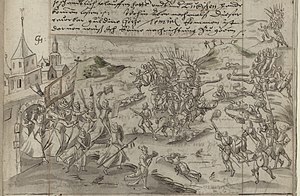Siege of Lübeck
| date | June 26, 1147 to June 28, 1147 |
|---|---|
| place | Lübeck |
| output | Holstein victory |
| Parties to the conflict | |
|---|---|
| Commander | |
|
unknown |
|
| Troop strength | |
| unknown | unknown |
| losses | |
|
at least 300 |
unknown |
The siege of Lübeck in the summer of 1147 was part of a campaign by the Abodrites under their prince Niklot in Wagrien , in the course of which the city and port were completely destroyed, while the castle, a little further away from the city, survived the siege.
background
The extensive preparations for the Wendekreuzzug during the spring of 1147 were not hidden from Niklot. In order to forestall the incursion of the Saxon-German army of crusaders into his territory, he decided to strike first. His intention was to take offensive action to keep enemy troops out of his own country and to turn the area of his opponents into a theater of war. The aim was first to take the strategically important outpost of Lübeck , which was owned by Count Adolf von Holstein , and then to advance through all of Wagrien .
For this purpose, Niklot had a navy and an army assembled in secrecy, which were ready for action in June 1147.
Course of the attack
The Abodritic fleet first landed at the mouth of the Trave in the Baltic Sea , from where Niklot sent a messenger to Count Adolf in Segeberg . Although the count stood on the side of his opponents out of loyalty to the Saxon princes, Niklot still felt a personal bond with him and had promised to give him a warning of attacks on his settlements; however, Adolf was absent and did not receive the message.
After Niklot had fulfilled his promise, the Slavic navy continued up the Traverse in the early morning of June 26th 1147. The crew of Lübeck Castle on the northern tip of today's old town island noticed the approaching enemy ships and tried to alert the residents of the two unpaved civilian settlements (on the banks of the Trave and in the area of today's market ). It did not succeed, however, in conveying the seriousness of the situation to the people of Lübeck and in making them ready for defense; According to legendary tradition, instead they carelessly celebrated the feast of the martyrs John and Paul with a boisterous drink and were taken by surprise by Niklot and his men in their sleep.
Because the residents did not respond, Niklot was able to land his troops without encountering resistance. The Abodrites surrounded the two settlements and during the following attack set the ships loaded with trade goods lying on the banks of the Trave ablaze with incendiary bullets. Helmold reports over three hundred deaths among the population. The only victim of the attack known by name is the priest and monk Rudolf (also: Ludolf), Vizelin's uncle , who was killed by Niklot's warriors while trying to escape into the castle.
After the successful attack on the civil settlements, the Abodrites began the siege of the Lübeck castle, while at the same time two troops of cavalry ravaged the surrounding area as far as Högersdorf and also destroyed the settlement below the castle of Segeberg.
The siege lasted two days, but despite great efforts and fierce fighting, the castle was not captured, so that Niklot had to withdraw in the end. The military goal of taking the important outpost on the Trave was unsuccessful, and the Slavic preventive strike now served as a justification for the Wendekreuzzug.
Battle of the Neilad
The siege of Lübeck was reflected in the local saga, recorded in the 16th century by Heinrich Rehbein and in 1852 by Ernst Deecke in his work Lübische Tales and Legends under the title Die Rasenden Weiber . According to the legend, the women of the town, upset by the unsuccessfulness and despondency of their men in the fight against the warriors of Niklot, seized all available weapons and made a sortie through the castle gate against the enemies lying on the castle field . The Abodrites believed they were facing fresh new troops, lost heart and fled to their ships, breaking the siege. According to the story, the place where the failure of women decided the fight was given the name Neilad , meaning sewing box .
Although the legend correctly captures the historical reason for the attack, the details have been imaginatively embellished and reinterpreted. There is no historical record of the failure of the women themselves, and allegedly, among the rich spoils of war that fell into the hands of the Lübeckers with the belongings of the attackers, the idol Temiel, poured entirely of pure gold, is said to have been found. The reason given for the drunkenness of the Lübeckers was the St. John's drink the day before; However, this is based on a mix-up, because according to Helmold von Bosau it was not about St. John's Day , which is celebrated with festivities , but rather the memorial day of the martyrs John and Paul , on which there are no celebrations with copious alcohol consumption. In contrast to these deviations from historical events, the legend left its mark on reality, as part of the castle field on which the event allegedly took place was still known as Neilad in the middle of the 19th century .
Web links
swell
- Helmold von Bosau : Slavic Chronicle . Retransmitted and explained by Heinz Stoob. Scientific Book Society, Darmstadt 1980 (Chapter 63)
- Ernst Deecke : Lübische stories and legends . Boldemann, Lübeck 1852
Remarks
- ↑ Helmold I, 63; to Karl Jordan : Heinrich the Lion. A biography . 4th edition. Deutscher Taschenbuch-Verlag, Munich 1996, ISBN 3-423-04601-5 , p. 37.
